A pitch for all reasons
 When the Turfcare's "Oscars" were awarded at a ceremony held in the SWALEC Stadium, Cardiff, Bath Rugby Club were declared the winner of the Public Sector Sports Ground of the Year. Receiving the trophy on the evening was Bath Rugby's Head Groundsman, Darren Ball, who has worked there for six years and been a core member of the council team that oversees the site.
When the Turfcare's "Oscars" were awarded at a ceremony held in the SWALEC Stadium, Cardiff, Bath Rugby Club were declared the winner of the Public Sector Sports Ground of the Year. Receiving the trophy on the evening was Bath Rugby's Head Groundsman, Darren Ball, who has worked there for six years and been a core member of the council team that oversees the site.
The club's home ground is officially Bath Recreation Ground, fondly known as "The Rec" and it is unique in occupying a central location in the historic city and being a truly public space. Once part of the Bathwick Estate, owned by the Forester family, it was leased in 1894 by Captain G W Forester to a body called The Bath and County Recreation Ground Company Limited. The company's instructions were that it should "make the ground available for cricket matches, lawn tennis, archery tournaments, football matches and other outdoor sports, including rugby matches and the construction of a pavilion", which still stands there today. The first major event to be established was a Somerset County Cricket Club Festival in 1897, and the tradition of providing first class cricket continues today.
The Rec has seen many changes over the decades, including the transfer of the site's control to Bath City Council in 1974 and, most notably, that the land became a c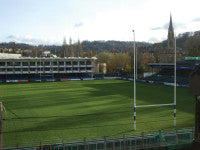 haritable trust in 2002 with the council as the sole trustee and managed by a Trust Board.
haritable trust in 2002 with the council as the sole trustee and managed by a Trust Board.
From a pitch care point of view, the diversity and frequency of sport and outdoor activity that take place on The Rec present a challenge faced by few other management teams.
Bath Rugby Club are one of a number of clubs that have their "home" there, and they received the award as part of a broad team of clubs and bodies that look after the ground, including the staff of Bath & North East Somerset Council (BANES). The Charities Commission, who monitor the use of The Rec, demanded in 2006 that "no single organisation dominated The Rec and it be available to the general public".
Although its most famous resident may be the 1998 Heineken Cup and 10-time John Player/Pilkington Cup winning Bath Rugby, a club that has provided England with such great players as Jeremy Guscott and the current England captain Lewis Moody, there is never the option of nurturing the hallowed turf in a way that Twickenham or the Millennium Stadium might enjoy.
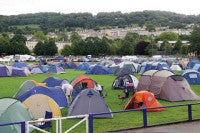
There are many other teams and clubs that call The Rec home, including Bath Croquet Club, The Spa Tennis Club, The Round Table Organisation (Guy Fawkes fireworks display) and Bath Lacrosse Club.
The Rec is also notable for hosting the oldest volleyball tournament in the UK, The Whitefield Tournament. This enters its 37th year in 2011 and is organised by The City of Bristol Volleyball Club in late July when they entertain 120 teams outdoors. Whilst not only providing some 28 turf-based courts for the event, the area that the rugby club uses becomes a tented village for competitors with tents, gas stoves and a vast amount of camping paraphernalia covering the ground.
The two-day festival induces severe wear and tear on the courts which demands major renovation work soon after. Slightly more unusual is the damage that is inflicted on the rugby pitch - it can look as if it's got a severe case of Chicken Pox after the tournament, as people put their pans of hot food and steaming kettles on the grass, killing it and leaving badly scarred 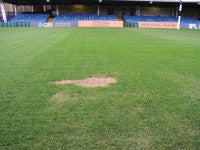 areas across the entire pitch. Repair work and debris removal has to be fastidious, so that valuable Premiership rugby players come to no harm from the discarded tent pegs and cutlery which are left by the campers.
areas across the entire pitch. Repair work and debris removal has to be fastidious, so that valuable Premiership rugby players come to no harm from the discarded tent pegs and cutlery which are left by the campers.
We are all familiar with Glastonbury Pop Festival mud, but no one would consider staging a top class sports event at Worthy Farm. But, The Rec can't be that exclusive. It hosts, annually, the Bath Half Marathon, in early March. The race has 11,000 competitors and the huge event involves large marquees and other facilities on the eastern area for the runners, supporters, media, charity organisations and first aiders. This event raises £1.2 million for charity each year, but bad weather frequently reduces the site to a morass of liquid mud under the 22,000 trainer-shod feet, as last happened in 2009.
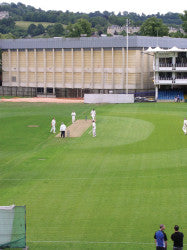
Summer events are numerous, including music concerts, a Coffee Festival, Family Fun Days and the Bath Fringe Creative Arts Festival - all require marquees, roadway tracking and parking facilities in and around The Rec.
Ironically though, the biggest summer function is the Somerset CCC Cricket Festival. Traditionally hosting four-day games, plans were put together in the summer of 2009 to enable the increasingly attractive spectacle of Twenty20 cricket to grace the green glade of this Georgian city. Cricket was one of the first sports hosted there in 1894 and this popular format, featuring the county team at The Rec, couldn't fail to be hugely attractive. However, to provide that, a new wicket had to be laid that September so that a dry-run match could be staged.
As anyone in turfcare management can appreciate, the complexities of catering for all those activities demands a concerted effort by groundstaff. Dave Gapper, senior team leader in the Sports Department of BANES explains, it is not easy. "We have a small team of staff that look after a large number of sites around Bath, and so I rely on individuals to manage particular sites on a day-to-day basis and draft in other professionals when required."
One of these is Ecosol Turfcare, for whom the new cricket wicket presented just one of many challenges as part of their renovation and grounds maintenance partnership with The Rec which begun almost four years ago. The wicket was duly constructed and, on 19th July 2010, a match took place between a Somerset Legends XI (208-4) and The Lord's Taveners XI (208-7), a tied game that brought the compliment of "the pitch played extremely well" from players such as Gloucester and England's Steve Kirby.
Chris Watt is the Chairman of the Trust Board and, in the 3½years he has been in that role, it has been his task to formulate and manage the long term strategy for The Rec. He has the unenviable task of balancing the aspects of income, recreational provision and the operation of commercial entities on land that is a Charitable Trust. "I feel that there are two primary challenges from the Trust's perspective: the first is that we have two top flight sporting sides here - Somerset CCC and Bath 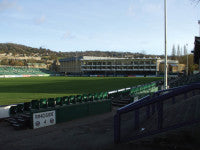 Rugby - and the very different turf quality demanded by each sport means that they may not, ordinarily, sit harmoniously with one another. One wants short grass with fast and flat outfield characteristics, while the other wants a well grassed, free draining environment." He continues, "The second task is to provide a facility that can cater for top flight sportsmen who can compete on a world stage, yet also accommodate amateur sports people and recreational usage - there can't be many sites that have that degree of diversity!"
Rugby - and the very different turf quality demanded by each sport means that they may not, ordinarily, sit harmoniously with one another. One wants short grass with fast and flat outfield characteristics, while the other wants a well grassed, free draining environment." He continues, "The second task is to provide a facility that can cater for top flight sportsmen who can compete on a world stage, yet also accommodate amateur sports people and recreational usage - there can't be many sites that have that degree of diversity!"
Dave Cobb looks after the cricket square (used for the four-day festival), two lawn tennis courts, three croquet lawns and the outfield area that gets separated from the rugby pitch between early August and late May. This eastern outfield area is where the majority of the sport and recreation takes place whilst, on the western side, Bath Rugby have their pitch and the familiar temporary East Stand. This is the area that Darren Ball, the club's head groundsman, looks after, as well as all the 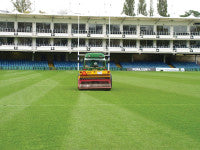 club's other training areas at Lambridge and Farleigh Hungerford (seven miles south of Bath). Dave Gapper continues, "In the seven years that I have been here, we have seen improvements made, but there is always a juggling act of being able to continue that improvement whilst contending with budgetary pressures, particularly in the last two years. Having said that, I estimate that we have seen a 30% increase in use since I joined the team, so we must be doing something right!"
club's other training areas at Lambridge and Farleigh Hungerford (seven miles south of Bath). Dave Gapper continues, "In the seven years that I have been here, we have seen improvements made, but there is always a juggling act of being able to continue that improvement whilst contending with budgetary pressures, particularly in the last two years. Having said that, I estimate that we have seen a 30% increase in use since I joined the team, so we must be doing something right!"
The award confirms that industry professionals and consultants have seen the technical improvements in the playing surfaces. This has not come about by chance. Management and maintenance programmes, which have been formulated by the Trust Board, BANES, Bath Rugby, Somerset CCC and Ecosol Turfcare, have resulted in better turf husbandry techniques being adopted and greater use. Concludes Chris Watt, "There are a number of parties involved in getting the best out of this facility and each has their own essential role to play. Teamwork and communication are as vital off-the-field in our roles, as they are for the rugby and cricket players on the field of play."
"What has changed in the last 3½ years to bring about this improvement?" The basic techniques of groundscare have always been performed at Bath, but the improvement in the past few years has been down to a more focussed management in targeted areas. The maintenance partnership with Ecosol Turfcare has been a success. "I'm delighted with their work," says Darren Ball. "During the 2007-8 season I was struggling to get my Lambridge training pitch in play and, at that point, I brough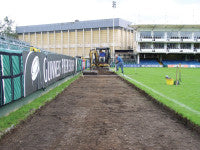 t in Bretton King and his company. Being local, their ability to get things done at the correct time made an immediate impact on all my surfaces. I had identified problems and knew what I wanted to do, but they helped me make it happen." This involvement did not go unnoticed by the managers at BANES and also by Chris Watt. As a result, tasks to address issues across the entire Recreation Ground gathered momentum and grass quality improved immediately.
t in Bretton King and his company. Being local, their ability to get things done at the correct time made an immediate impact on all my surfaces. I had identified problems and knew what I wanted to do, but they helped me make it happen." This involvement did not go unnoticed by the managers at BANES and also by Chris Watt. As a result, tasks to address issues across the entire Recreation Ground gathered momentum and grass quality improved immediately.
Whilst still having to operate within the confines of his budgets, Dave Gapper knows that, if something needs doing and he doesn't have the kit to do it with, the company can react quickly and provide him with what he may need. "When we had the volleyball tournament in 2010, grass wear was terrible and our overseeding 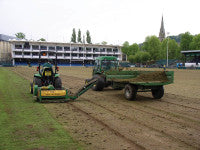 equipment was not up to the task. Instead of just leaving the area to regenerate itself, we were able to get their Vredo drill in and overseed when the right conditions were there." Darren agrees, adding, "We are really happy with the team and their work. They respond quickly and take great pride in what they do.
equipment was not up to the task. Instead of just leaving the area to regenerate itself, we were able to get their Vredo drill in and overseed when the right conditions were there." Darren agrees, adding, "We are really happy with the team and their work. They respond quickly and take great pride in what they do.
Having built the new cricket wicket in 2009, and seen a need to provide a better cricket outfield for 2010, as well as dealing with an increasing Poa presence in the rugby pitch, Darren decided to use the Koro Field Top Maker to strip the top off the pitch, removing 30mm of vegetation and rootzone. The pitch was re-graded to remove high and low spots and then topdressed with 100 tonnes of 50/50 rootzone. A further 80 tonnes of sand was injected using the Blec Sandmaster to re-establish links with the gravel bands installed eight years previously and accelerate water off the surface. Reseeding with Advanta MM60 took place immediately and, despite a very dry summer and the occurrence of public events on the pitch, the grass flourished.
"It has 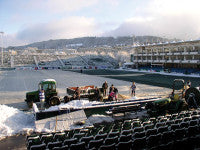 come back brilliantly," said Darren. "It was a radical treatment in the context of what else had to be hosted later in the summer, but there's no question the pitch has done better than it would, had we not removed the old surface. Following the first games of the 2010 season and a lot of rain, it held together well and, in January 2011, is still fully grassed."
come back brilliantly," said Darren. "It was a radical treatment in the context of what else had to be hosted later in the summer, but there's no question the pitch has done better than it would, had we not removed the old surface. Following the first games of the 2010 season and a lot of rain, it held together well and, in January 2011, is still fully grassed."
He also instructed Ecosol to install a new perimeter drain to prevent water running off the concourses of the Wadworth and Hampton stands to the west and south of the ground - water which traditionally encroached onto the pitch after torrential downpours. New all-weather Verdegrass was laid in the technical areas, enhancing the appearance of the 12,300 seat stadium and reducing turf damage.
Another challenge that may be presented more often is one of snow. The season had prog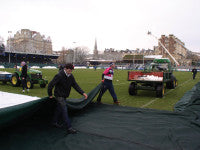 ressed well until 18th December 2010, when everyone in Bath and the South West awoke to a 15cm (6") carpet of snow. With a Heineken Cup match against Ulster scheduled for transmission on Sky Sports that afternoon, and faced with a potential penalty running to thousands of pounds if they didn't stage it, clearance had to be swift.
ressed well until 18th December 2010, when everyone in Bath and the South West awoke to a 15cm (6") carpet of snow. With a Heineken Cup match against Ulster scheduled for transmission on Sky Sports that afternoon, and faced with a potential penalty running to thousands of pounds if they didn't stage it, clearance had to be swift.
With the collective efforts of a dozen BANES staff, Bath Rugby staff, Ecosol Turfcare's and a number of dedicated Bath Rugby fans, snow clearing began in earnest at 7.00am. By 1.10pm. 85 tonnes had been cleared from the pitch, whilst leaf blowers and gritting gangs had made safe all the walkways to enable the all-clear to be given by the Safety Officer. A quick charge around the pitch with the line marker (to satisfy the French referee!!) and the pitch was ready for its scheduled 1.30pm kick-off, much to the relief of all. TV viewers weren't even aware that it had snowed!
